The trouble with Troublesome Creek: How one KY stream became the center of a flood disaster
Kelly Smith doesn’t know where he’ll go.
But wherever it is, it won’t be around Troublesome Creek, Smith said as he was rifling through the rubble and mud of his little slice of bottomland earlier this month in Eastern Knott County, a community called Fisty that was ravaged by historic flooding.
“I’ve lost 50 years here,” Smith said. “The flood destroyed everything I got.”
Smith, 67, did well for himself there.
He ran a trucking business, a scrap yard, a small self-serve car wash, and rented some apartments out of a building that used to house a post office and a business specializing in insurance claim restoration projects. He also hid two prized possessions — mint condition Camaro sports cars from 1968 and ‘67 — in a cavernous garage that flooded.
Smith watched it happen up close, from an apartment window above the small two-car wash that floodwaters reached.
In a matter of hours, all of it got junked by a rising Troublesome Creek.
A little kingdom in Fisty, mostly gone because of a flood that far exceeded any he’d ever seen. Smith had no insurance.
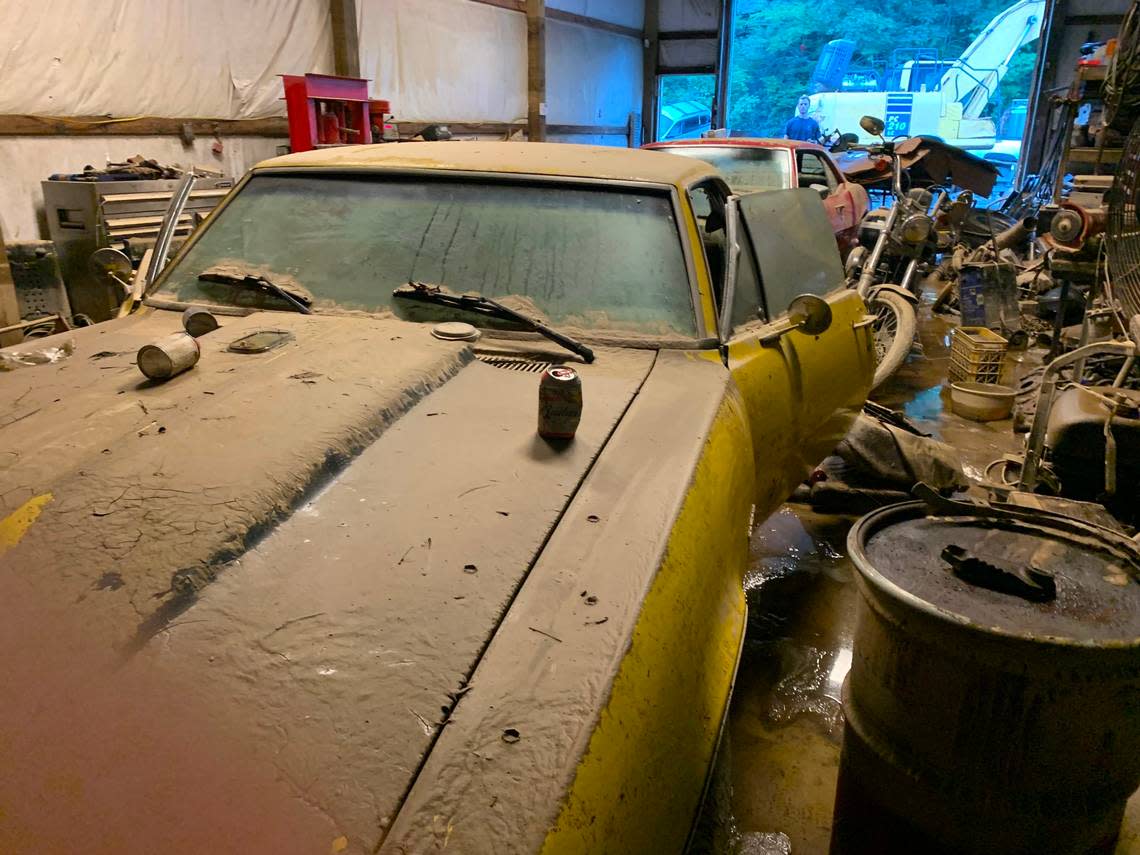
Take a drive down the roads that snake along much of the creek’s bank — KY-550 and 476 — and you’ll see dozens more patches of bottomland like Smith’s. Little communities cut off from the road because a bridge washed out, a baseball field whose fences are completely caked in mud and debris, and scores of homes whose walls got soaked or were completely washed away.
Tons of trash and debris are still stuck on bends in the creek where branches, other debris, or lower water levels stopped them before they moved along into the Kentucky River, which feeds into the Ohio, the Mississippi, then the Gulf of Mexico.
Residents agree that Troublesome Creek is aptly named, though its origins are uncertain: depending on who you ask, the stream got its name from Civil War soldiers having difficulty crossing it, or from a spate of floods in the pioneer days.
Either way, the creek spelled trouble for residents like Smith. For at least 39 people region-wide, the catastrophe caused death. The flooded Troublesome Creek, and the streams that feed into it, killed nearly half of the victims of July’s historic flooding across Kentucky’s Appalachian East.
The destruction leaves many mourning the loss of life and sense of peace along Troublesome Creek’s banks and wondering why this creek, of all the Appalachian rivulets, became the most deadly in the flooding.
‘Big gush’ meets ‘climate Zero’
In many ways, there is a simple answer for why the flood hit Troublesome Creek so hard: a lot of rain over a sustained period and a whole lot of it in the hours leading up to the worst of the floods.
Chris Barton, a professor of Forest Hydrology and Watershed Management at the University of Kentucky, kept a close eye on data from a weather station at Robinson Forest in Breathitt County. His station recorded nine inches of rain over July 26, 27 and 28 when the flooding became deadly for so many.
Those rains in the days leading up to the horrendous July 28 event saturated the soils and stressed the ephemeral streams (waterways that only activate during significant rainfall) that feed into small perennial streams, which feed into Troublesome Creek.
Then, from 10 p.m. on Wednesday the 27th to 3 a.m. on Thursday, Barton said the most intense rainfall event he’s observed there occurred when four inches came down in just five hours.
“Your soils were saturated and water was already flowing. When that big gush came at 10 p.m., the system just couldn’t handle it,” Barton said.
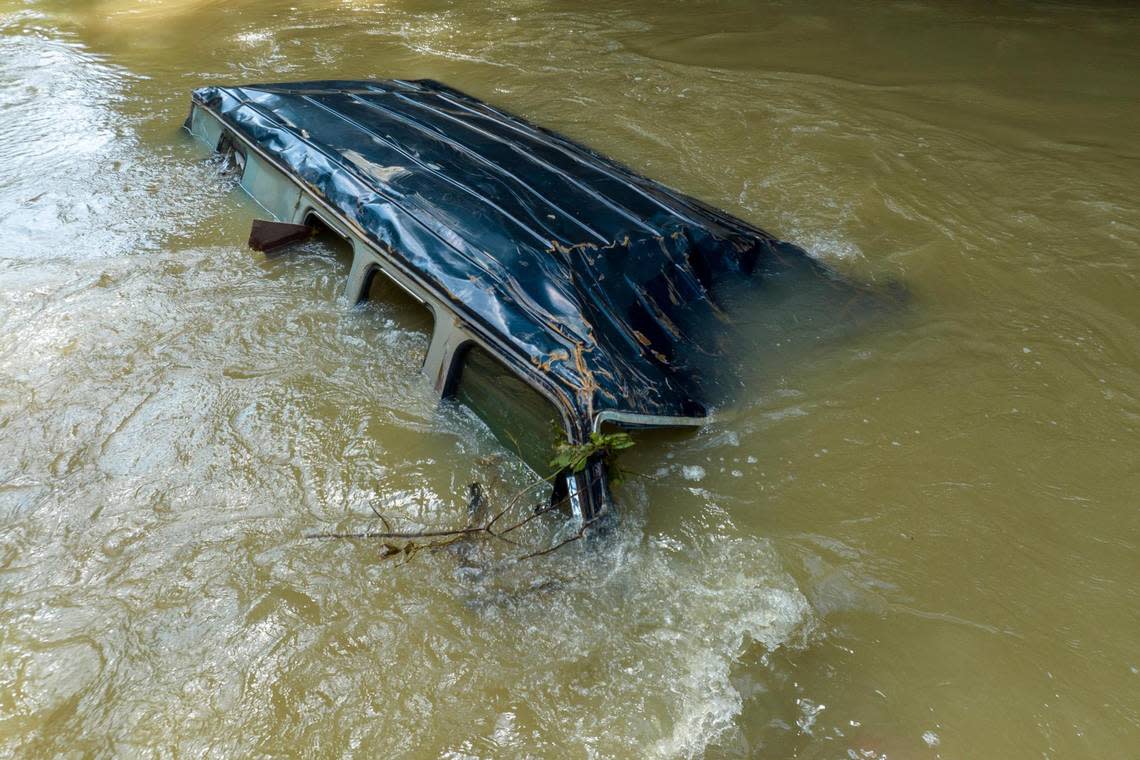
The readings from Robinson Forest suggest that the rainfall was more intense there than in the region writ large, since the National Weather Service recorded eight inches in the Jackson area, which covers several Eastern Kentucky counties.
Barton emphasized the importance of thinking about the whole system in the event that made Troublesome Creek such a “meat grinder,” as one local put it. It’s not just a story about one creek, but hundreds of overwhelmed ephemeral streams and watersheds feeding into one creek that’s usually a peaceful little stream.
For every mile of perennial stream, there are 10 miles of ephemeral streams, Barton said.
Of course, many of the comments Barton and other scientists made aren’t exclusive to Troublesome Creek and the areas around it. For instance, the steep and sometimes rocky terrain in that area and elsewhere in Eastern Kentucky contributed to the floods, according to Kentucky State Geologist Bill Haneberg
“If water falls in a very flat area, it has lots of time to slowly percolate into the ground, to the extent that the soil can absorb it. If it’s in a very steep area, it runs off very quickly. The soils in Appalachia in general tend to be rocky so they may not have the same capacity to absorb,” Haneberg said.
Nicolas Zegre, an Associate Professor of Forest Hydrology at the University of West Virginia, said that as much as there’s a particular story to tell about how Troublesome Creek got so bad locally, attention should also be paid to climate change’s role in increased flooding.
Zegre called Appalachia “climate zero,” like patient zero or the first person to get a disease in a pandemic. The region is among the first to face the consequences of a carbon-extractive economy, he said, and that economy fueled by coal in this region fed many families and lined many wallets before suffering a downturn in recent decades.
“It’s climate zero because we’re not only the source of part of the carbon, but we’re also disproportionately vulnerable to the impacts of more carbon in the atmosphere because our people live in mountainous watersheds. Our entire built environment is within reach of a stream.”
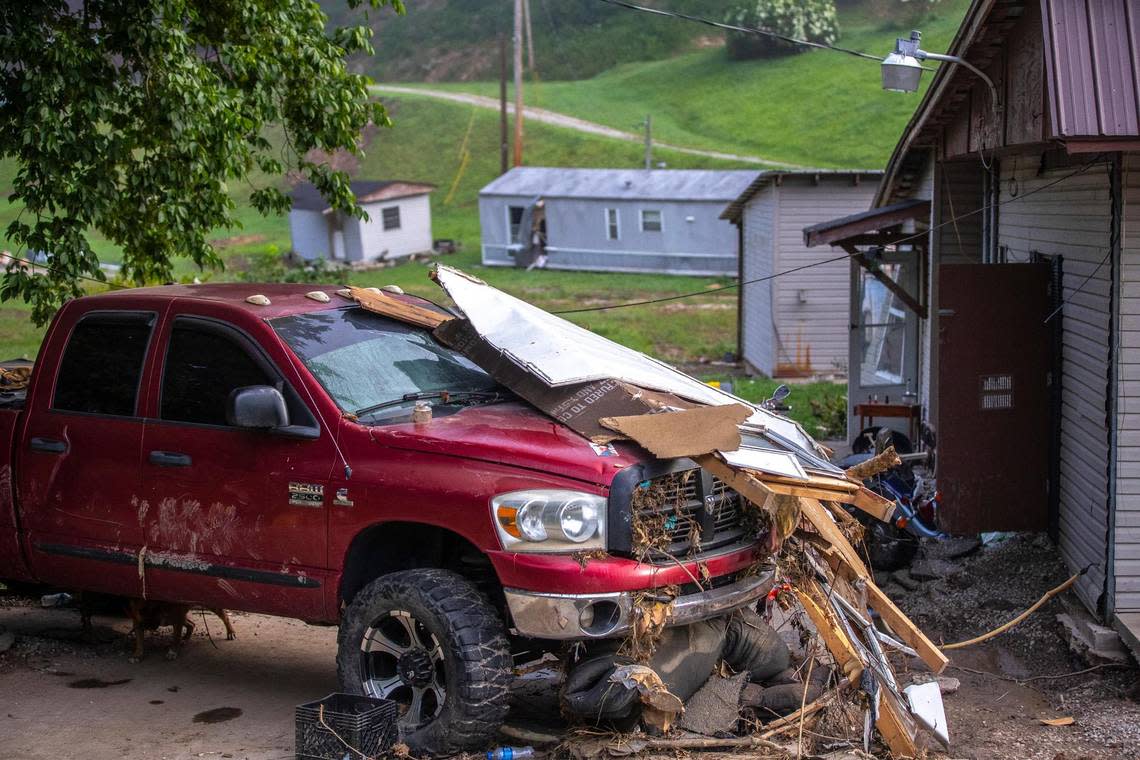
Fighting a flood recovery on two fronts
Hindman Mayor Tracey Niece said his theme song was country singer Jackson Browne’s “Running on Empty.”
That’s because he’s fighting a flood recovery battle on two fronts: His entire town went underwater in the height of the event, killing three citizens in city limits. He also lost everything that he owns to the water.
In the wee hours of the morning, Niece and his family fled the home that’s been in his family for more than 50 years for higher ground near the road. Niece could only watch as the waters he’d fished and swam in as a little boy took over his brick home.
“I was watching my history of my family, where I grew up and played for years, disappear. There’s no words to describe it. It’s just a sunken feeling,” Niece said.
Main street in Hindman looked like you could go whitewater rafting on it, he said.
For now, Niece’s focus is on getting bridges for communities still cut off back up and the city’s sewer system online – they’ve had water for some days, but no functioning sewer system.
His family was one of a lucky few with flood insurance, but his specific policy may not make him so lucky.
Niece says that he’s been mostly stiffed by the insurance company because he only had structural insurance on his home.
“They’re telling me that the brick on the outside of my house, there is no structural damage. It’s not cracked or anything like that,” Niece said. “And I’m like, ‘Okay, what about the floor joists, the floor buckling up, the walls that are 2x4, the rafters. The interior structure is totally a disaster, and I don’t think they’re gonna cover it.”
Hindman, native Allison Slone said, was a great place to grow up.
Allison Slone, who now lives in Morehead, remembers her early years growing up in Hindman on a house high up a hill across the road from Troublesome Creek.
She remembers halcyon days of crossing the road to dig for crawdads in the creek, and the almost familial warmth with which almost everyone in the area greeted her. Her family made a lot of jokes, too – and the recent tragedy made her recall one in particular about the end times.
“We used to laugh and say ‘if the water ever got up near to our house, the world was gonna end,’” Slone said.
On the morning of the flood, the water did just that.
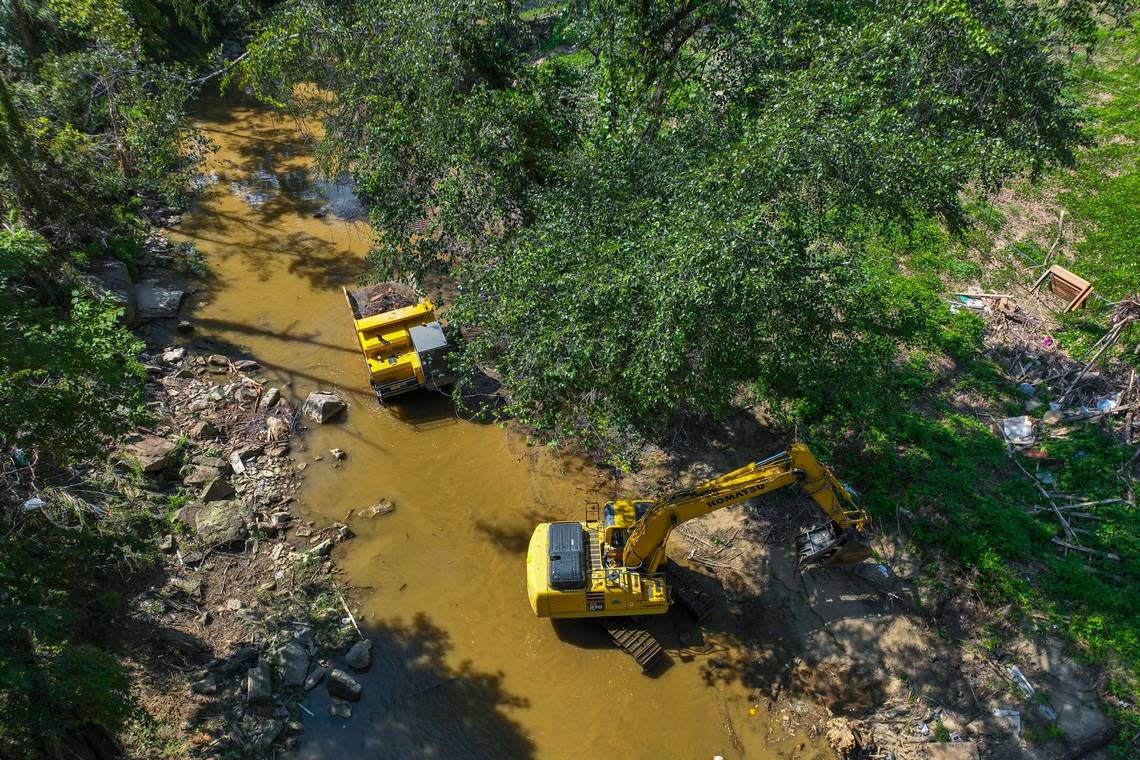
Strip mining means ‘more water in the system’
Troublesome Creek is straddled by sizable former strip mine sites – Star Fire near Ary almost hugs the creek, while a site near Chavies and the newly reclaimed Mine Made Adventure Park are only a few miles away on either side.
The prevalence of mountaintop removal has raised the question of how strip mining might have affected the severity of the floods.
But researchers have a word for what we know about the effect of the practice on flooding: equivocal.
“Whether it’s a forested or mined watershed, if people live in a narrow holler in a V-shaped valley downstream, they were gonna be impacted,” Zegre said.
One documented reason that strip mining, or mountaintop removal, is likely to make floods worsen is that the soil is heavily compacted.
The mining practice’s effect on floods, Zegre said, is still equivocal because the harm of soil compaction has yet to be fully weighed against the benefits of having several hundred acres of flat land – where water can rest before being whisked away by gravity to lower ground.
“Loss of infiltration means that more water is going to run off. We have a lot of data that would suggest that would happen, but the reality of it is that the sites aren’t nearly as steep as they were before they were mined. In a natural, unmined forest, there’s nowhere for water to sort of hang out or be stored,” Barton.
Barton knows from experience. Part of the reason he keeps a close eye on Robinson Forest is that he also monitors the nearby former Star Fire mine site, which sits a little over halfway down Troublesome Creek’s length, for a university project.
He helps with the effort of trying to reforest the Star Fire site, a project that started in the late 1990s. About 70% of the native species where the team used low compaction reclamation techniques survive.
Trees are important, and the lack of them on strip mine sites could cause flooding to worsen, because their canopy catches a certain amount of rain and their roots absorb some precipitation as well.
“When you get rid of the trees, you sort of shut off that pump, which means there’s gonna be more water in that system,” Barton said.
In the aftermath of the flooding, a tiny stream that runs down from Star Fire was completely overwhelmed. Chunks of soil several feet wide had been ripped off the sides of the stream by the floodwaters.
Zegre said that the greater exposure of soils on a strip mine site to weather make those soils more likely to run off.
“When you have a surface mine, there’s a lot of that geologic material that can erode and mobilize. That sedimentation then goes into the stream channels, and it fills in the stream channels. That means there’s less storage in the natural stream channel than would be if there was not a mine,” Zegre said.
There are retention basins, sediment ponds and diversion ditches on many mines that are meant to help with runoff issues, though those could fail in a severe enough event, Barton said.
Plaintiffs in the River Caney community, whose sit along a tiny creek just below one of the strip mines in both Troublesome Creek and the North Fork of the Kentucky River’s watersheds, just filed a lawsuit against a surface mining company for the alleged failure of its silt ponds, which they claim led to mass destruction in their community and contamination of their drinking water.
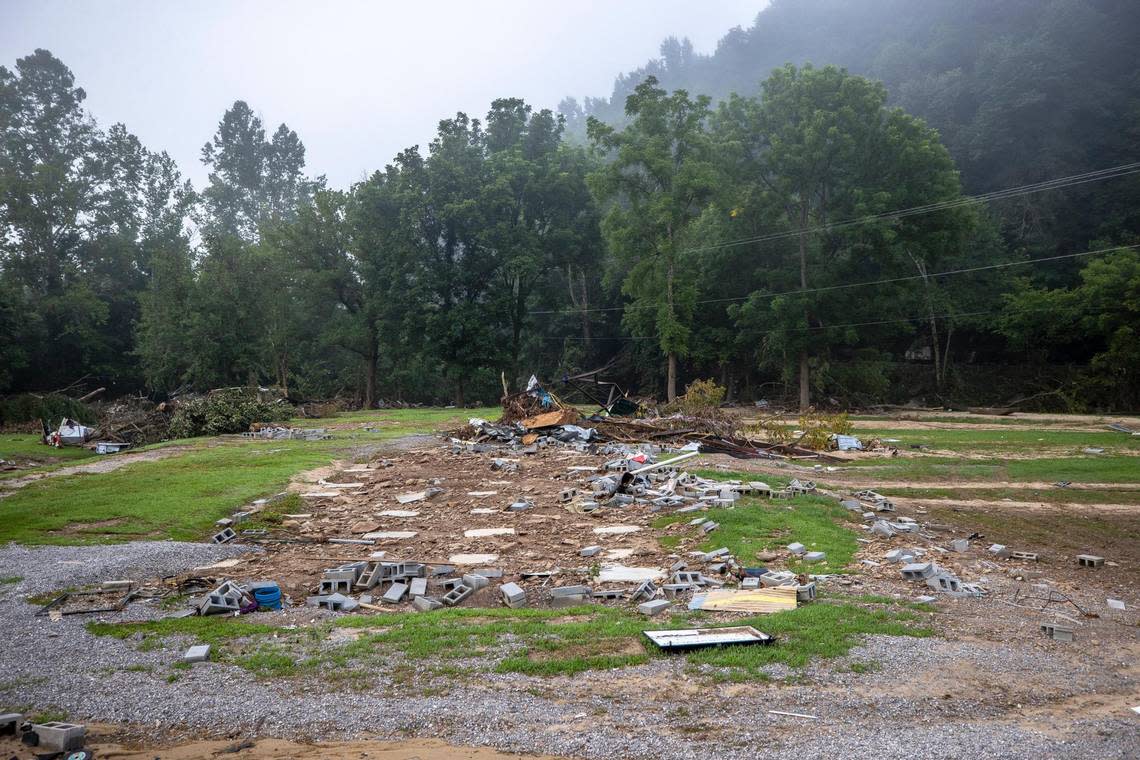
Rising water and ‘no way out’
Gary Click lives in a part of Carrie that was not considered a floodplain.
He thought he and his wife Wilma were in the clear that morning, even taking a less fortunate neighbor onto his porch to watch the water.
But soon, they found themselves retreating inside. Water rose up to their chests as they prayed it didn’t rise any further.
“It was like the Titanic – you done hit the iceberg. There’s no way out,” Click said.
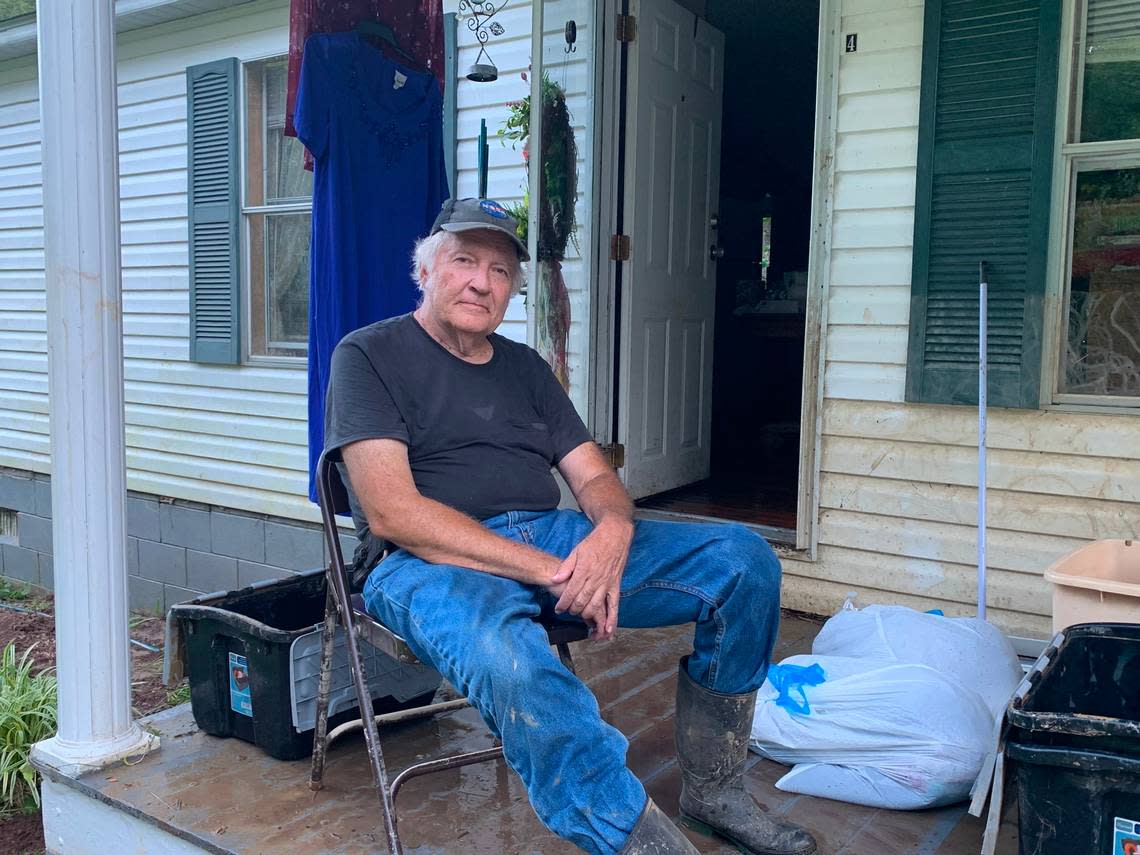
Thankfully, that’s where the flooding stopped.
Click, a retired data processor for regional grocery chain IGA, was able to buy up a sizable slice of bottom land surrounding his trailer on Troublesome Creek over the years. He was pretty excited about its potential because the county government had recently cleaned the creek up.
“It was a fairly decent little tributary of water, not just filth and debris, but guess what: it’s right back where it started,” Click said.
All half-dozen structures were overwhelmed with mud and water and the Click family had no insurance. A 500-gallon collection tank from a gas well now sits in the creek behind his property.
The flooding was so bad in his part of the creek that friends from church approached him at a relief center and called him “Lazarus,” after the biblical character that Jesus raised from the dead.
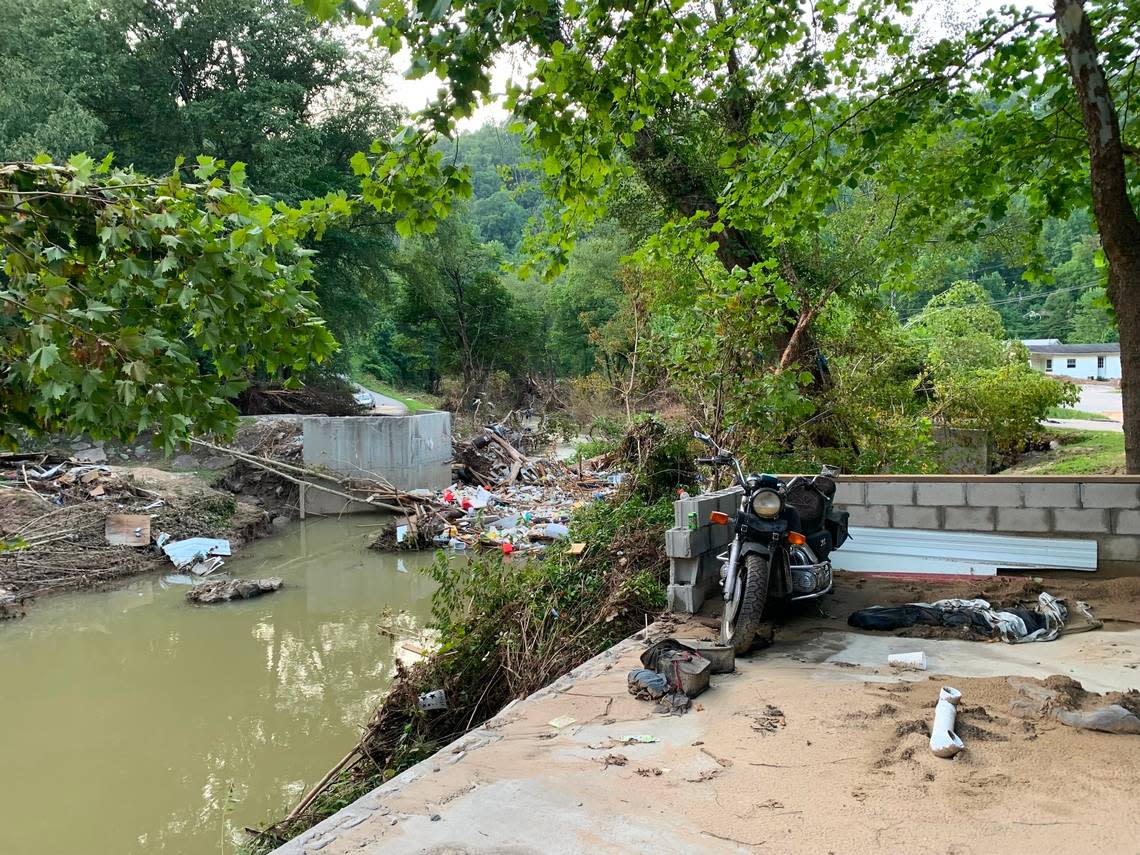
Could dredging the creek help?
Some believe that dredging streams – clearing out the bottom of a stream bed of mud and debris – is the answer to mitigating floods in places like Troublesome Creek.
But rules around when groups can dredge are stringent. Some states have banned certain types of dredging, and federal rules protecting habitats for animals like crawdads are limiting the ability for governments or groups to dredge several miles of creek.
On Troublesome Creek, a federal determination that the arrow darter, a small fish, is endangered and that it has habitats on Troublesome Creek in 2016 barred it from being dredged without a federal permit.
Senate President Robert Stivers, R-Manchester, said that there was frustration among some with the stringent rules that often disallow governments from dredging their creeks.
“We’re going to be interested in tiger mussels, but not the people that died in Eastern Kentucky,” Stivers asked rhetorically.
That frustration exists among Eastern Kentucky state legislators on both sides of the aisle.
“I’m a Democrat. I’m all about protecting the environment, but we have to be able to dredge those creeks,” Rep. Angie Hatton, D-Whitesburg, said. “I know it’s gonna start happening in Letcher County where we don’t flood because our creeks are going to be full the next time it rains, and it’s gonna get worse every time.”
Matt Daley, director of communications and logistics for Emergency Disaster Services in Lexington and a native of Hindman where the flooding was particularly costly, said that he thinks the issue needs to be closely examined.
He laid blame at the feet of the U.S. Army Corps of Engineers, which is tasked with administering certain environmental regulations and with federal flood protection projects.
“The Army Corps of Engineers, as good and as intelligent as those people are, have been very slow to dredge our waterways in a way that would help at least limit the deluge and the blockage of water that then can’t withstand that kind of rainfall. If you dredge Troublesome Creek a couple times, there’s a good chance there would be, let’s say, 15 people that are still alive because of that,” Daley said.
The agency has not yet responded to questions about how many permits have been sought on Troublesome Creek and in Eastern Kentucky, or how many of them have been approved.
Barton and Zegre, the two hydrologists, say that asking the corps to change rules on dredging may not be the answer.
Natural streams in general have a way of regulating themselves more efficiently than humans, they said.
Barton said that it simply isn’t an option in many creeks like Troublesome. Very often, the bottom of those streams aren’t far from bedrock as is.
“The streams are going to naturally cut in floods. When they cut down and get to bedrock, then they start to widen, and that means you’re losing even more of that precious floodplain,” Barton said. “In a system like this – a mountainous stream system – that wouldn’t be an option. Nature’s taking care of that one.”
Zegre said that in certain instances, dredging could be beneficial, but the larger problem is land use – surface mining, road building, tree removal and farming – that changes the natural equilibrium of the watershed.
“The land use practices that result in more sediment going into the stream. That’s actually what the problem is. And simply by dredging a stream you’re not solving the problem.
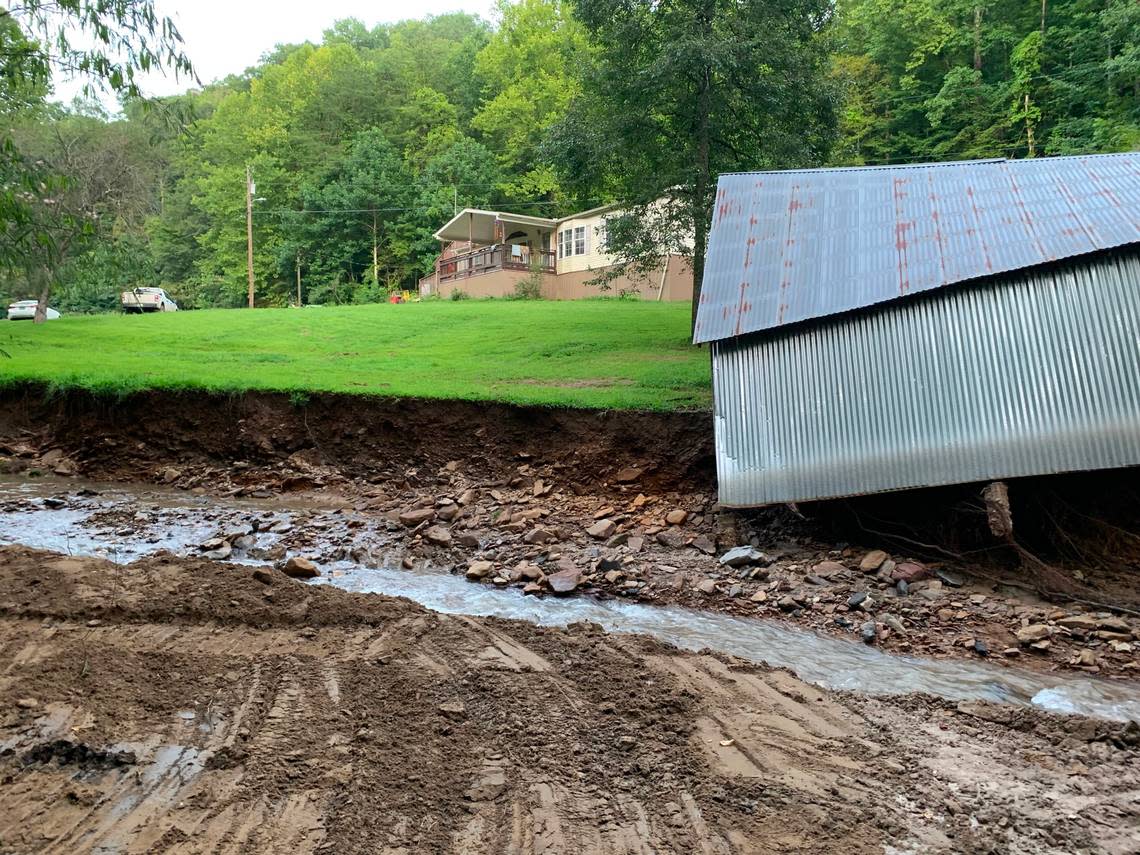
‘Destroyed again:’ Recovering from multiple disasters
Dana Fugate was postmaster at the Lost Creek Post Office, at the intersection where that stream feeds Troublesome Creek, for 19 years.
Two houses down from the Lost Creek post office along Troublesome, Fugate knew a couple that had worked hard over the years to improve their home on KY-476. Now all that’s left of the structure is blocks, she said.
And the wife was among the dead.
“They found her and identified her by her pacemaker,” Fugate said.
A figure in the Breathitt County community, Fugate served on the long-term recovery team from March 2021 floods that rocked the area. She knows how long bouncing back from a disaster significantly less devastating took.
“A lot of these people that had just gotten situated, just thought ‘okay, I can get back to my life,’ they’re destroyed again,” Fugate said.
The people of that area look after their own, Fugate said. She knows because she’s enjoyed many a gifted egg sandwich for breakfast, along with jars of strawberry jam.
“They are just very real people. My grandmother was from up in that area and my dad went to school over there. Once they found out who I was, I was family,” Fugate said. “They’re mountain people, and mountain people are the best in my opinion.”
Residents concerned over future of historic Eastern Ky. community center after flooding
